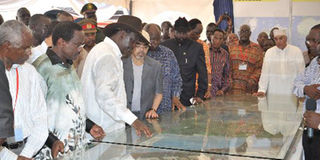MARKETS: Kenyans to own piece of oil pipeline

President Mwai Kibaki, Prime Minister Raila Odinga South Sudan President Salva Kiir and Ethiopia Prime Minister Meles Zenawi, look at the model of Lamu Port during the official launch of the multi-trillion Lamu Port-Southern Sudan-Ethiopia Transport (lappset) Corridor Project. PHOTO | FILE
What you need to know:
- In 2013, a conglomerate led by China Communications Construction Company won a Sh42 billion tender for the construction of the first three berths of the port.
- The cost of constructing the pipeline, which is one of the flagship projects under the Lapsset project, is estimated at Sh360 billion ($4 billion). The pipeline would connect Kenya’s Lamu port with landlocked oil-producing South Sudan to facilitate crude exports.
- It is expected that the project would inject between two and three per cent of the gross domestic product into Kenya’s economy once completed.
Kenyans would get a chance to invest in some of the projects under the Lamu-Southern Sudan-Ethiopia Transport (Lapsset) through buying of shares.
Lapsset director-general, Sylvester Kasuku said the oil pipeline to be constructed under the project would be the first to be listed on the Nairobi Securities Exchange.
Its listing would give Kenyans a chance to own a piece of the multi-billion shillings investment.
“The pipeline is one of the components of the project we have identified to be listed on the stock market.
This will give Kenyans a chance to participate in its ownership,” Mr Kasuku said at the Jomo Kenyatta University of Agriculture and Technology last week ahead of the institution’s 20th anniversary.
The cost of constructing the pipeline, which is one of the flagship projects under the Lapsset project, is estimated at Sh360 billion ($4 billion). The pipeline would connect Kenya’s Lamu port with landlocked oil-producing South Sudan to facilitate crude exports.
Uganda is also likely to use the pipeline to export its black gold through the Lamu port. The Lamu port, whose construction is scheduled to start this month, would cost about Sh450 billion ($5 billion).
In 2013, a conglomerate led by China Communications Construction Company won a Sh42 billion tender for the construction of the first three berths of the port.
FAILURE TO LAUNCH
Lapsset is expected to open up economic opportunities in Kenya’s northern frontier, a hardship area that has remained marginalised for a long time.
Currently, the government is identifying transaction advisers for the project that would connect Kenya, Ethiopia, South Sudan and Uganda through the Lamu port, which is located on Kenya’s North Coast.
Tap into region
“We want to make Kenya the centre at the edge. We are tapping into the region as our main resource centre,” Mr Kasuku noted.
The Sh2.7 trillion Lapsset project was launched in 2012 by retired President Mwai Kibaki together with former Ethiopian Prime Minister Meles Zenawi and South Sudan President Salva Kiir.
It has, however, taken long to take off due to, among other things, delays over compensation of land owners at the port and along the project’s corridor.
The government has since disbursed Sh860 million to compensate people whose land has been acquired for the port construction.
Feasibility studies and engineering designs for most of the projects along the transport corridor are scheduled for completion in May this year, ushering in full-scale development of a major infrastructure project in East Africa.
A significant proportion of Ethiopia’s 90 million population is concentrated on the southern parts of the landlocked country. Roads and rail lines connecting Kenya and Ethiopia would help open up a crucial market — the second most populous country in Africa.
Other projects earmarked for construction along the corridor are three resort cities — Lamu, Turkana and Isiolo — a rail line, a pipeline, international airports and a highway. The railway, highway and pipeline would run parallel to each other “in view of the need for road transport in the construction and maintenance of all the other components,” says a Lapsset executive summary document.
It is expected that the project would inject between two and three per cent of the gross domestic product into Kenya’s economy once completed.
Last month, Lapsset project was elevated to the African Union’s Presidential Infrastructure Champion Initiative (PICI). This opened up the project for discussions among the PICI members on its implementation.
As regional governments move to develop infrastructure to ease movement of goods and people, competition is also heating up in the port development between Kenya and Tanzania.
The latter is planning to construct an $11 billion port at Bagamoyo to rival that of Mombasa.
THE NUMBERS
2.7trn
Cost in shillings of all Lapsset projects.
360bn
What the oil pipeline under Lappset would cost in shillings. There is plan to list the pipeline at the NSE
450bn
Cost in shillings of Lamu port whose construction is set to start this month





